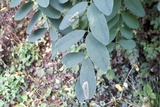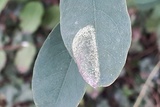Macrosaccus robiniella (Clemens, 1859) Species
Last modified: Dec. 10, 2025, 2:26 p.m.
A native species to North America and accidentally introduced to Europe and first recorded near Basel, Switzerland in 1983. In Belgium recorded for the first time in 2001 in LI. Expands rapidly throughout the country. Hitherto a fairly common species.
Details
- Classification
- Family: Gracillariidae > Subfamily: Lithocolletinae > Genus: Macrosaccus > Species: Macrosaccus robiniella
- Vernacular names
- Robiniavouwmot (NL), Leaf blotch miner moth (EN), Robinienminiermotte (DE)
- First mention in Belgium
- De Prins W. & Groenen F. 2001. Phyllonorycter robiniella, een nieuwe soort voor de Belgische fauna (Lepidoptera: Gracillariidae). — Phegea 29(4): 159–160. On page 159. view page
- Status
-
Naturalised In Belgium since September 2001.
This invasive species has a North American origin where it is widespread. It was accidentally introduced into Switzerland (Basel) in 1983 and from there spread over Central Europe. It was first found in The Netherlands in 2000 (province of South Limburg) and probably invaded Belgium from those populations. It has spread all over Belgium since then, except for LX (2018).
Distribution
Imago
The forewing ground color is orange-brown, with two large, white striae at the costa and two supplementary, but much smaller striae before the apex. A semi-circular black dot in the apical area.
Museum specimens
No pictures yet!Specimens in nature
No pictures yet!Mine
De first instar lives in a very short gallery at the underside of a leaf and widens this into a circular, or oval white blotch. This blotch never crosses the main vein of the leaf. On the upperside of the leaf, the blotch is visible as an oval patch with a different shade of green than the rest of the leaf.
See also gracillariidae.net and bladmineerders.be.
Cocoon/pupa
A pure white, silken cocoon inside the white blotch mine.
Bionomics
Typical for this species is that several larvae can occur in the same blotch. Though they start their mining life individually, their blotch mines might sometimes touch and merge and then the caterpillars live and pupate in the same large blotch.
The adults hatch in late autumn and hibernate.
Flight periods
The adults fly in three generations a year, which are indistinguishable from May to October.
Observed on
- Host plant (species):
- Robinia pseudoacacia
The larva is monophagous on Robinia pseudoacacia.
Habitat
Parks, street plantations with Robinia pseudoacacia, an invasive plant itself.



